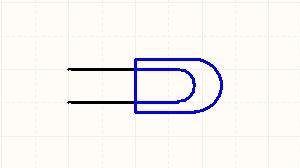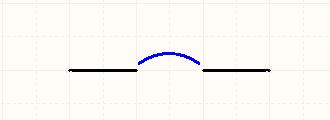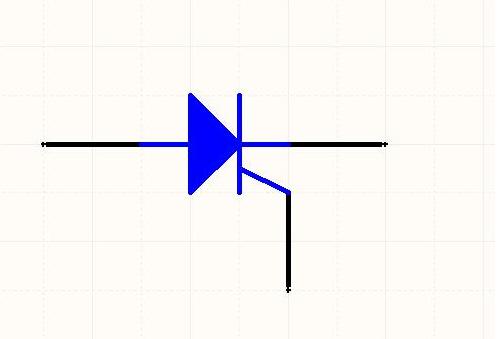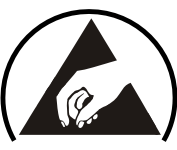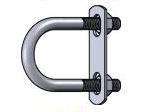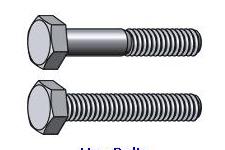FCC Exam Questions: Quiz!
This FCC Exam Questions: Quiz! assesses knowledge of electronic components through schematic symbols. It covers antennas, capacitors, transistors, and various diodes, essential for learners in electronics and electrical engineering.
(83).webp)
- 2.
What does this schematic symbol represent?
-
Diode
-
Antenna
-
Capacitor (unpolarized)
-
Trash Compactor
Correct Answer
A. Capacitor (unpolarized)Explanation
This schematic symbol represents a capacitor that is unpolarized. A capacitor is an electronic component that stores electrical energy in an electric field. The fact that it is unpolarized means that it can be connected in either direction in a circuit, unlike polarized capacitors which have a specific positive and negative terminal.Rate this question:
-
- 3.
What does this schematic symbol represent?
-
N-Channel MOSFET
-
PNP Transistor
-
NPN Transistor (BJT)
-
Schottky Diode
Correct Answer
A. NPN Transistor (BJT)Explanation
The schematic symbol represents an NPN Transistor (BJT). A BJT, or Bipolar Junction Transistor, is a three-layer semiconductor device commonly used for amplification or switching of electronic signals. The NPN configuration consists of two N-type layers sandwiching a P-type layer. The symbol shows an arrow pointing outwards from the base, indicating the direction of conventional current flow when the transistor is in active mode.Rate this question:
-
- 4.
What does this schematic symbol represent?
-
Tunnel Diode
-
Varactor Diode
-
Schottky Diode
-
Bridge Rectifier
Correct Answer
A. Schottky DiodeExplanation
A Schottky diode is a type of diode that has a low forward voltage drop and a fast switching speed. It is commonly used in high-frequency applications, rectification of low voltage signals, and as a protection diode in circuits. The schematic symbol for a Schottky diode consists of a triangle pointing towards a horizontal line, representing the anode and cathode terminals respectively. The answer choice "Schottky Diode" correctly identifies the schematic symbol being referred to in the question.Rate this question:
-
- 5.
What does this schematic symbol represent?
-
Rectifier Diode
-
Schottky Diode
-
Tunnel Diode
-
Varactor Diode
Correct Answer
A. Varactor DiodeExplanation
A varactor diode is a specialized type of diode that is used for voltage-controlled capacitance. It is commonly used in electronic circuits for tuning or frequency modulation applications. The symbol shown in the schematic represents a varactor diode, which consists of two parallel lines with a diagonal line in between, indicating the two terminals of the diode.Rate this question:
-
- 6.
What does this schematic symbol represent?
-
Tunnel Diode
-
Varactor Diode
-
Battery
-
Zener Diode
Correct Answer
A. Zener DiodeExplanation
This schematic symbol represents a Zener Diode. A Zener diode is a type of diode that operates in the reverse-biased breakdown region, allowing current to flow in the reverse direction when a certain voltage, known as the Zener voltage, is reached. It is commonly used as a voltage regulator or in voltage reference applications.Rate this question:
-
- 7.
What does this schematic symbol represent?
-
BJT - NPN
-
BJT - PNP
-
P-Channel MOSFET
-
N-Channel J-FET
Correct Answer
A. BJT - PNPExplanation
This schematic symbol represents a BJT - PNP (Bipolar Junction Transistor - PNP). A BJT is a three-layer semiconductor device that can amplify or switch electronic signals and is commonly used in electronic circuits. The PNP type BJT consists of a layer of p-type semiconductor sandwiched between two layers of n-type semiconductor. The symbol represents the arrangement of these layers and the direction of current flow.Rate this question:
-
- 8.
What does this schematic symbol represent?
-
NPN Darlington
-
NPN Phototransistor
-
LED
-
Triac
Correct Answer
A. NPN PhototransistorExplanation
This schematic symbol represents an NPN phototransistor. A phototransistor is a type of transistor that is sensitive to light. It is designed to amplify and switch electronic signals and is commonly used in applications such as light sensors and optical communication systems. The NPN configuration indicates that the transistor is made up of three layers of semiconductor material, with a layer of N-type material sandwiched between two layers of P-type material.Rate this question:
-
- 9.
What does this schematic symbol represent?
-
Triac
-
P-Channel MOSFET
-
N-Channel MOSFET
-
NPN BJT
Correct Answer
A. N-Channel MOSFETExplanation
The schematic symbol represents an N-Channel MOSFET. MOSFET stands for Metal-Oxide-Semiconductor Field-Effect Transistor, which is a type of transistor used for amplifying or switching electronic signals. The N-Channel MOSFET has a channel formed by a positively charged substrate with two negatively charged regions on either side. When a positive voltage is applied to the gate terminal, it creates an electric field that allows current to flow through the channel. This symbol is commonly used in circuit diagrams to represent an N-Channel MOSFET.Rate this question:
-
- 10.
What does this schematic symbol represent?
-
P-Channel Metal-Oxide Semiconductor Field Effect Transistor (MOSFET)
-
NPN Bipolar Junction Transistor (BJT)
-
Thermistor
-
Silicone-Controlled Rectifier (SCR)
Correct Answer
A. P-Channel Metal-Oxide Semiconductor Field Effect Transistor (MOSFET)Explanation
This schematic symbol represents a P-Channel Metal-Oxide Semiconductor Field Effect Transistor (MOSFET). A MOSFET is a type of transistor that is used for amplifying or switching electronic signals. The P-Channel MOSFET has a P-type semiconductor as the channel between the source and drain terminals. The symbol represents the structure of a MOSFET, with the gate terminal controlling the flow of current between the source and drain terminals.Rate this question:
-
- 11.
What does this schematic symbol represent?
-
N-Channel JFET
-
P-Channel JFET
-
NPN BJT
-
Pushbutton Switch
Correct Answer
A. N-Channel JFETExplanation
This schematic symbol represents an N-Channel JFET (Junction Field-Effect Transistor). JFETs are three-terminal devices used for controlling the flow of current in electronic circuits. The N-Channel JFET is a type of JFET where the channel is formed by an N-type semiconductor material. It is commonly used in amplifiers, switches, and other electronic devices.Rate this question:
-
- 12.
What does this schematic symbol represent?
-
PNP Transistor (BJT)
-
P-Channel JFET
-
P-Channel MOSFET
-
N-Channel MOSFET
Correct Answer
A. P-Channel JFETExplanation
This schematic symbol represents a P-Channel JFET. JFET stands for Junction Field Effect Transistor, and it is a type of transistor that uses a voltage applied across a semiconductor channel to control the current flow. The P-Channel JFET has a P-type channel and is controlled by a negative voltage applied to the gate terminal.Rate this question:
-
- 13.
What does this schematic symbol represent?
-
Fingernail
-
Microphone
-
Incandescent Bulb
-
Thermistor
Correct Answer
A. Incandescent BulbExplanation
This schematic symbol represents an incandescent bulb. It is commonly used to represent a light source in electrical circuit diagrams. The symbol consists of a circle with a cross inside it, representing the filament of the bulb, and two lines extending from the circle, representing the electrical connections. Incandescent bulbs produce light by heating a filament until it glows, and they are commonly used in household lighting applications.Rate this question:
-
- 14.
What does this schematic symbol represent?
-
Thermistor
-
Fuse
-
Circuit Breaker
-
Push Button Switch
Correct Answer
A. Circuit BreakerExplanation
This schematic symbol represents a circuit breaker. A circuit breaker is a device that automatically interrupts or breaks an electrical circuit when it detects an overload or short circuit. It is designed to protect electrical circuits and prevent damage to equipment or electrical fires. When an excessive current flows through the circuit, the circuit breaker trips and opens the circuit, stopping the flow of electricity. Once the issue is resolved, the circuit breaker can be reset to restore power to the circuit.Rate this question:
-
- 15.
What does this schematic symbol represent?
-
Varistor
-
Resistor
-
Fuse
-
Capacitor
Correct Answer
A. VaristorExplanation
This schematic symbol represents a varistor. A varistor is an electronic component that is used to protect circuits from excessive voltage. It acts as a voltage-dependent resistor, meaning its resistance decreases as the voltage across it increases. This allows it to absorb and dissipate high voltage spikes or surges, protecting the circuitry from damage. The symbol typically consists of two parallel lines with a diagonal line connecting them, representing the nonlinear voltage-current characteristic of a varistor.Rate this question:
-
- 16.
What does this schematic symbol represent?
-
Varistor
-
Capacitor
-
Variable Capacitor (Trimmer Cap)
-
Transformer
Correct Answer
A. Variable Capacitor (Trimmer Cap)Explanation
This schematic symbol represents a variable capacitor, also known as a trimmer cap. A variable capacitor is a type of capacitor that allows the capacitance value to be adjusted manually or electronically. It is commonly used in electronic circuits where precise tuning or adjustment of capacitance is required. The symbol consists of two parallel lines with an arrow pointing towards them, indicating the adjustable nature of the capacitor.Rate this question:
-
- 17.
What does this schematic symbol represent?
-
SCR (Silicone Controlled Rectifier)
-
Triac
-
Tunnel Diode
-
Bridge Rectifier
Correct Answer
A. SCR (Silicone Controlled Rectifier)Explanation
This schematic symbol represents an SCR (Silicone Controlled Rectifier). An SCR is a type of semiconductor device that acts as a switch for controlling the flow of electric current. It is commonly used in electronic circuits for applications such as power control and voltage regulation. The symbol consists of three layers of semiconductor material, with an additional control terminal. When a small current is applied to the control terminal, it triggers the SCR to allow a larger current to flow through it.Rate this question:
-
- 18.
What does this schematic symbol represent?
-
SCR
-
Triac
-
Schottky Diode
-
Variable Diode
Correct Answer
A. TriacExplanation
A Triac is a three-terminal electronic component that functions as a bidirectional switch. It is commonly used in AC power control applications, such as dimming lights or controlling the speed of motors. The symbol for a Triac in a schematic diagram consists of two back-to-back thyristors, with a gate terminal in the middle. This allows current to flow in both directions when triggered by a small current applied to the gate terminal. Therefore, the correct answer is Triac.Rate this question:
-
- 19.
What does this schematic symbol represent?
-
Push Button
-
Speaker
-
Bell
-
Microphone
-
Mushroom
Correct Answer
A. BellExplanation
This schematic symbol represents a bell.Rate this question:
-
- 20.
What does this schematic symbol represent?
-
Fuse
-
Circuit Breaker
-
Thermistor
-
Normally-Open Push-button Switch
Correct Answer
A. Normally-Open Push-button SwitchExplanation
This schematic symbol represents a normally-open push-button switch. This type of switch is designed to be normally open, meaning that the circuit is not complete when the switch is in its default position. When the button is pressed, it closes the circuit and allows the current to flow through. This type of switch is commonly used in applications where a momentary connection or interruption of the circuit is required.Rate this question:
-
- 21.
What does RoHS stand for?
-
Reduction of Hazardous Substances
-
Restriction of Hazardous Substances
-
Reuse of Hazardous Substances
Correct Answer
A. Restriction of Hazardous SubstancesExplanation
RoHS stands for Restriction of Hazardous Substances. This acronym refers to a directive that restricts the use of certain hazardous substances in electrical and electronic equipment. The purpose of RoHS is to protect human health and the environment by reducing the amount of hazardous materials, such as lead, mercury, and cadmium, in products. By restricting the use of these substances, RoHS aims to promote the development and use of safer and more environmentally friendly alternatives.Rate this question:
-
- 22.
What are some of the materials affected by RoHS legislation?
-
Lead
-
Cadmium
-
Chlorine
-
PCBs
-
Hexavalent chromium
-
Polybrominated biphenyls
-
Gasoline
-
Polybrominated diphenyl ether (PBDE)
Correct Answer(s)
A. Lead
A. Cadmium
A. Hexavalent chromium
A. Polybrominated biphenyls
A. Polybrominated diphenyl ether (PBDE)Explanation
RoHS legislation restricts the use of certain hazardous substances in electrical and electronic equipment. The materials affected by RoHS legislation include lead, cadmium, hexavalent chromium, polybrominated biphenyls (PBBs), and polybrominated diphenyl ether (PBDE). These substances are harmful to human health and the environment, and their restriction aims to reduce their negative impact. Chlorine, gasoline, and PCBs are not specifically mentioned in the context of RoHS legislation and therefore are not considered materials affected by it.Rate this question:
-
- 23.
RoHS Legislation was introduced by the Canadian Government
-
True
-
False
Correct Answer
A. FalseExplanation
RoHS is a European initiative.Rate this question:
-
- 24.
What does this symbol mean?
-
Static Sensitive - Do Not Touch
-
Static Shielding
-
Do not put hand inside triangle
Correct Answer
A. Static Sensitive - Do Not TouchExplanation
The symbol indicates that the object or area is static sensitive and should not be touched. Static sensitive components are vulnerable to damage caused by electrostatic discharge (ESD) from human touch. This symbol serves as a warning to prevent individuals from coming into contact with the object or area in order to avoid potential damage.Rate this question:
-
- 25.
You see this symbol on a plastic bag. What does it mean?
-
The bag shields against Electrostatic Discharge (ESD)
-
Keep the Contents Dry
-
The bag should not be handled without ESD Protection
-
Do not use bubble soap inside
Correct Answer
A. The bag shields against Electrostatic Discharge (ESD)Explanation
The symbol on the plastic bag indicates that it provides protection against Electrostatic Discharge (ESD). ESD can occur when there is a sudden flow of electricity between two objects, which can damage sensitive electronic components. This symbol serves as a warning to handle the bag with caution and use appropriate ESD protection to prevent any potential damage to the contents inside.Rate this question:
-
- 26.
What does ESD stand for?
-
Educational System Dispersion
-
Electronic System Detection
-
Electrostatic Discharge
Correct Answer
A. Electrostatic DischargeExplanation
ESD stands for Electrostatic Discharge. Electrostatic discharge refers to the sudden flow of electricity between two electrically charged objects caused by contact, an electrical short, or a dielectric breakdown. This discharge can result in damage to electronic components and devices.Rate this question:
-
- 27.
A drawing in which the part appear to move while the "observer" remains fixed is called a _______________? (Hint: This type of drawing is NOT common in North America)
-
Parallelogram
-
First-Angle Projection
-
Third-Angle Projection
-
Schematic Diagram
Correct Answer
A. First-Angle ProjectionExplanation
A drawing in which the part appears to move while the "observer" remains fixed is called a First-Angle Projection. This type of drawing is commonly used in engineering and technical fields to represent three-dimensional objects on a two-dimensional plane. In a first-angle projection, the object is placed in the first quadrant and the observer is positioned looking at the object from behind. The image is then projected onto a plane, creating the illusion of movement when the observer remains fixed.Rate this question:
-
- 28.
What type of fastener is this?
-
Sheet Metal Screw
-
Wood Screw
-
Machine Screw
Correct Answer
A. Wood ScrewExplanation
This type of fastener is called a wood screw because it is specifically designed to be used in wood materials. Wood screws have a tapered point and coarse threads that provide a strong hold in wood, making them ideal for woodworking projects. They are often used to join pieces of wood together or to attach hardware to wooden surfaces.Rate this question:
-
- 29.
What type of fastener is this?
-
Set Screw
-
Carriage Bolt
-
Machine Screw
Correct Answer
A. Machine ScrewExplanation
This fastener is identified as a machine screw. Machine screws are threaded fasteners that are designed to be used with a tapped hole or nut to securely fasten two or more components together. They have a uniform diameter along their entire length and are typically used in machinery and equipment where a tight and secure connection is required. Set screws are similar, but they do not have a tapered head like machine screws. Carriage bolts have a round head and a square neck, which prevents them from turning when tightened.Rate this question:
-
- 30.
What type of fastener is this?
-
Thread-Cutting Machine Screw
-
Sheet Metal Screw
-
Wood Screw
Correct Answer
A. Thread-Cutting Machine ScrewExplanation
A thread-cutting machine screw is a type of fastener that is designed to create threads in a pre-drilled hole. It is typically used in metal applications where a strong and secure connection is required. This type of screw has a sharp, pointed tip and a coarse thread pattern that allows it to cut into the material as it is being driven in. It is not designed for use in wood or sheet metal applications, which is why the other options are incorrect.Rate this question:
-
- 31.
What type of fastener is this?
-
Hex Bolt
-
Wood Screw
-
Sheet Metal Screw
Correct Answer
A. Sheet Metal ScrewExplanation
This fastener is a sheet metal screw. Sheet metal screws are designed specifically for fastening metal sheets together. They have a sharp point and threads that are spaced closely together, allowing them to securely grip the thin metal sheets. The other options, hex bolt and wood screw, are not suitable for fastening metal sheets and have different features and uses.Rate this question:
-
- 32.
What type of fastener is this?
-
Eye Bolt
-
U-Bolt
-
Lag Bolt
Correct Answer
A. U-BoltExplanation
This fastener is called a U-Bolt. It is a type of bolt that has a U-shaped bend and threads on both ends. It is commonly used to secure pipes, cables, or other objects to surfaces. The U-shape allows for easy installation and provides a secure grip around the object being fastened.Rate this question:
-
- 33.
What type of fastener is this?
-
Sex Bolt
-
Set Screw
-
Socket Screws
Correct Answer
A. Sex BoltExplanation
You better believe it! http://www.boltdepot.com/fastener-information/Type-Chart.aspxRate this question:
-
- 34.
What type of fastener is this?
-
Wood Screw
-
Self-Drilling Sheet Metal Screw
-
Machine Screw
Correct Answer
A. Self-Drilling Sheet Metal ScrewExplanation
The correct answer is Self-Drilling Sheet Metal Screw. This type of fastener is specifically designed to drill its own hole in sheet metal, eliminating the need for pre-drilling. It has a sharp, pointed tip and a threaded body that allows it to securely fasten metal sheets together. Wood screws are designed for use in wood, while machine screws are typically used with nuts or tapped holes in metal.Rate this question:
-
- 35.
What type of fastener is this?
-
Machine Screw
-
Carriage Bolt
-
Hex Bolt
Correct Answer
A. Hex BoltExplanation
This fastener is a hex bolt because it has a hexagonal head, which allows for easy tightening and loosening using a wrench or a socket. Hex bolts are commonly used in construction and machinery, as they provide a secure and durable fastening solution.Rate this question:
-
- 36.
What type of fastener is this?
-
Machine Screw
-
Hex Bolt
-
Carriage Bolt
Correct Answer
A. Carriage BoltExplanation
A carriage bolt is a type of fastener that has a smooth, dome-shaped head and a square or hexagonal shoulder beneath the head. It is designed to be used with a nut and is commonly used in woodworking applications where a smooth finish is desired. The smooth head of the carriage bolt prevents it from snagging on materials and allows for a clean, finished appearance.Rate this question:
-
- 37.
What type of fastener is this?
-
Elevator Bolt
-
Hanger Bolt
-
Sex Bolt
Correct Answer
A. Hanger BoltExplanation
A hanger bolt is a type of fastener that has a threaded shaft on one end and a wood screw thread on the other end. It is commonly used to hang or secure objects to wooden surfaces. The threaded end of the hanger bolt can be screwed into a pre-drilled hole in the wood, while the wood screw end can be used to attach objects such as brackets or hooks. This type of fastener provides a strong and secure connection between the object and the wooden surface.Rate this question:
-
- 38.
What drive type is this?
-
Robertson
-
Phillips / Frearson
-
Allen
Correct Answer
A. Phillips / FrearsonExplanation
The correct answer is Phillips / Frearson. Phillips / Frearson is a type of drive that is commonly used in screws and screwdrivers. It has a cross-shaped recess with rounded edges, allowing for better torque transmission and reducing the risk of cam-out. This type of drive is widely used in various industries and applications, making it a popular choice for fastening materials together.Rate this question:
-
- 39.
What drive type is this?
-
Frearson
-
Phillips
-
Slotted
Correct Answer
A. SlottedExplanation
The correct answer is Slotted because Slotted refers to a type of drive that has a single straight slot in the screw head, allowing it to be turned using a flat-blade screwdriver. The other options, Frearson and Phillips, are different types of drives with different slot configurations.Rate this question:
-
- 40.
What drive type is this?
-
Pozi-Drive
-
Combination
-
Torx
Correct Answer
A. CombinationExplanation
The drive type in question is a Combination drive. This type of drive combines two different drive types, typically a Phillips and a slotted drive, into one. It allows for the use of either type of screwdriver, providing versatility and convenience.Rate this question:
-
- 41.
What drive type is this?
-
Hex
-
Robertson
-
Torx
Correct Answer
A. HexExplanation
The correct answer is Hex because Hex refers to a type of drive commonly found on screws and bolts. It has a hexagonal shape with six sides, allowing for better grip and torque when using a wrench or an Allen key. The other options, Robertson and Torx, are different types of drive systems commonly used in screws and bolts, but they are not the correct answer in this case.Rate this question:
-
- 42.
What drive type is this?
-
Robertson
-
Pozi-Drive
-
Socket
Correct Answer
A. RobertsonExplanation
The correct answer is Robertson because Robertson is a type of drive used in screws and fasteners. It is characterized by a square-shaped socket in the screw head, which provides a secure and efficient grip for the screwdriver. Pozi-Drive and Socket are not drive types, but rather refer to different types of screw heads or tools.Rate this question:
-
- 43.
What drive type is this?
-
Hex
-
Allen
-
Torx
Correct Answer
A. TorxExplanation
Torx is a type of drive that is commonly used in automotive and electronics industries. It has a six-pointed star-shaped pattern with a central pin, which provides better torque transfer and reduces the risk of cam-out (slippage) compared to other drive types like hex or Allen. Torx screws are known for their durability and ability to handle high torque applications, making them a popular choice in various industries.Rate this question:
-
- 44.
What type of washer is this?
-
Flat
-
Fender
-
Finishing
Correct Answer
A. FlatExplanation
This question is asking about the type of washer being referred to. The answer is "Flat" because a flat washer is a type of washer that has a flat surface and is typically used to distribute the load of a threaded fastener, such as a bolt or nut.Rate this question:
-
- 45.
What type of washer is this?
-
Flat
-
Fender
-
Finishing
Correct Answer
A. FinishingExplanation
This type of washer is called a "finishing" washer. Finishing washers are used to provide a decorative and finished appearance to the surface of the material being fastened. They have a larger outer diameter and a smaller inner diameter, creating a raised lip around the screw or bolt. This helps to distribute the load evenly and prevent damage to the material. Finishing washers are commonly used in woodworking and furniture applications.Rate this question:
-
- 46.
What type of washer is this?
-
Tooth Lock
-
Dock
-
Split-Lock
Correct Answer
A. Split-LockExplanation
The given options "Tooth Lock," "Dock," and "Split-Lock" suggest different types of washers. Among these options, "Split-Lock" is the correct answer as it refers to a type of washer that has a split design, allowing it to be easily inserted and removed from a bolt or screw. This type of washer is commonly used to prevent loosening or rotation of fasteners and provides a secure and tight fit.Rate this question:
-
- 47.
What type of washer is this?
-
External Tooth Lock
-
Internal Tooth Lock
-
Spikey Washer
Correct Answer
A. External Tooth LockExplanation
This type of washer is called an external tooth lock washer. It is used to prevent a nut or bolt from loosening under vibration or torque by providing a gripping surface between the fastener and the mating surface. The external teeth on the washer bite into the material, creating friction and preventing rotation. This type of washer is commonly used in automotive, construction, and industrial applications.Rate this question:
-
- 48.
What type of washer is this?
-
Internal Tooth Lock
-
External Tooth Lock
-
Spikey Washer
Correct Answer
A. Internal Tooth LockExplanation
This type of washer is called an internal tooth lock because it has teeth on the inner side of the washer that grip onto the surface it is placed against. These teeth help to prevent the washer from rotating or loosening when under pressure or vibrations, providing a secure fastening solution.Rate this question:
-
- 49.
What type of washer is this?
-
Lock Washer
-
Dock Washer
-
Square Washer
Correct Answer
A. Square WasherExplanation
The correct answer is Square Washer because a square washer is a type of washer that has a square shape with a hole in the center. It is commonly used in construction and engineering applications to provide a larger bearing surface and distribute the load evenly. The square shape helps to prevent the washer from rotating, providing better stability and security.Rate this question:
-
Quiz Review Timeline (Updated): Oct 10, 2023 +
Our quizzes are rigorously reviewed, monitored and continuously updated by our expert board to maintain accuracy, relevance, and timeliness.
-
Current Version
-
Oct 10, 2023Quiz Edited by
ProProfs Editorial Team -
Oct 31, 2010Quiz Created by
ELENWorkgroup
 Back to top
Back to top















